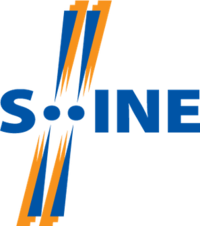NA61 experiment
NA61/SHINE (standing for "SPS Heavy Ion and Neutrino Experiment") is a particle physics experiment at the Super Proton Synchrotron (SPS) at the European Organization for Nuclear Research (CERN).[1] The experiment studies the hadronic final states produced in interactions of various beam particles (pions, protons and beryllium, argon, and xenon nuclei) with a variety of fixed nuclear targets at the SPS energies.
 | |
| Key SPS Experiments | |
|---|---|
| UA1 | Underground Area 1 |
| UA2 | Underground Area 2 |
| NA31 | NA31 Experiment |
| NA32 | Investigation of Charm Production in Hadronic Interactions Using High-Resolution Silicon Detectors |
| COMPASS | Common Muon and Proton Apparatus for Structure and Spectroscopy |
| SHINE | SPS Heavy Ion and Neutrino Experiment |
| NA62 | NA62 Experiment |
| SPS preaccelerators | |
| p and Pb | Linear accelerators for protons (Linac 2) and Lead (Linac 3) |
| (not marked) | Proton Synchrotron Booster |
| PS | Proton Synchrotron |

About 135 physicists from 14 countries and 35 institutions work in NA61/SHINE, led by Marek Gazdzicki. NA61/SHINE is the second largest fixed target experiment at CERN.
Physics program
The NA61/SHINE physics program has been designed to measure hadron production in three different types of collisions:[1]
- In nucleus–nucleus (heavy ion) collisions, in particular the measurement of fluctuations and long range correlations, with the aim to identify the properties of the onset of deconfinement and find evidence for the critical point of strongly interacting matter.
- In proton–proton and proton–nucleus interactions needed as reference data for better understanding of nucleus–nucleus reactions; in particular with regards to correlations, fluctuations and high transverse momenta.
- In hadron–nucleus interactions needed for neutrino (T2K) and cosmic-ray experiments (Pierre Auger Observatory and KASCADE).
Detector
The NA61/SHINE experiment uses a large acceptance hadron spectrometer located on the H2 beam line in the North Area of CERN.[1] It consist of components used by the heavy ion NA49 experiment as well as those designed and constructed for NA61/SHINE.[2]
The main tracking devices are four large volume time projection chambers (TPCs), which are capable of detecting up to 70% of all charged particles created in the studied reactions. Two of them are located in the magnetic field of two super-conducting dipole magnets with maximum bending powers of 9 Tesla meters. Two others are positioned downstream of the magnets symmetrically with respect to the beam line. The setup is supplemented by time of flight detector walls, which extend particle identification to low momenta (1 GeV/c < p ). Furthermore, the Projectile Spectator Detector (a calorimeter) is positioned downstream of the time of flight detectors to measure energy of projectile fragments.
Collected data
- pion-beryllium interactions at 120 GeV/c in 2016,
- pion-carbon interactions at 30 GeV/c, 60 GeV/c, 158 GeV/c and 350 GeV/c in 2009, 2012, 2016, and 2017,
- pion-aluminium interactions at 60 GeV/c in 2017,
- kaon-carbon interactions at 158 GeV/c in 2012,
- proton-proton interactions at 13, 20, 31, 40, 80, 158 and 400 GeV/c in 2009, 2010, 2011, and 2016,
- proton-beryllium interactions at 60 GeV/c and 120 GeV/c in 2016 and 2017,
- proton-carbon, proton-(T2K replica target) and proton-(NOvA replica target) interactions at 31 GeV/c, 60 GeV/c, 90 GeV/c, and 120 GeV/c in 2007, 2009, 2010, 2012, 2016, 2017, and 2018,
- proton-aluminium interactions at 60 GeV/c in 2016,
- proton-lead interactions at 30, 40, 80 and 158 GeV/c in 2012, 2014, 2016, and 2017,
- beryllium-beryllium interactions at 13A, 19A, 30A, 40A, 75A and 150A GeV/c in 2011, 2012, and 2013,
- carbon-carbon and carbon-(CH2) interactions at 13A GeV/c in 2018,
- argon-scandium interactions at 13A, 19A, 30A, 40A, 75A and 150A GeV/c in 2015,
- xenon-lanthanum interactions at 13A, 19A, 30A, 40A, 75A and 150A GeV/c in 2017,
- lead-lead interactions at 13A, 30A and 150A GeV/c in 2016 and 2018.
References
-
Antoniou, N.; et al. (NA61 Collaboration) (2006). "Study of hadron production in hadron–nucleus and nucleus–nucleus collisions at the CERN SPS". Proposal. SPSC-P-330, CERN-SPSC-2006-034. Cite journal requires
|journal=(help) - Abgrall, N.; et al. (NA61 Collaboration) (2014). "NA61/SHINE facility at the CERN SPS: beams and detector system". Journal of Instrumentation. 9 (2–3): P06005. arXiv:1401.4699. Bibcode:2014JInst...9P6005A. doi:10.1088/1748-0221/9/06/P06005.